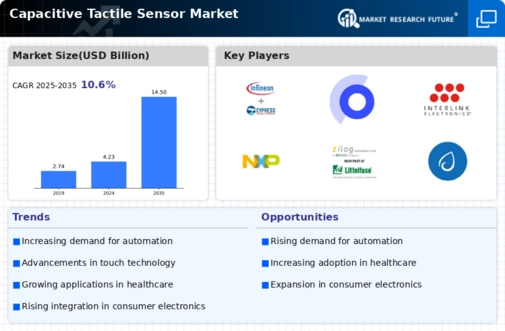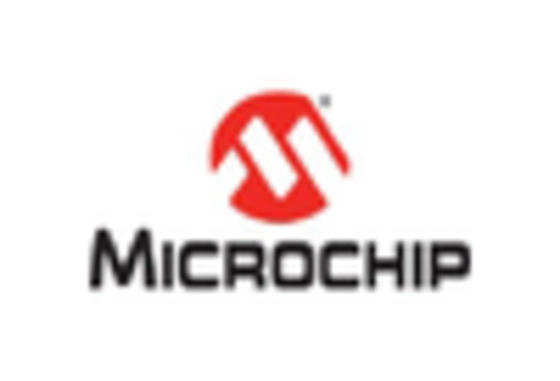Focus on Enhanced User Experience
A focus on enhanced user experience is driving the Capacitive Tactile Sensor Market. Companies are increasingly recognizing the importance of user-centric design in product development. Capacitive tactile sensors facilitate a more engaging and interactive experience, which is essential in today’s competitive landscape. Industries such as gaming, healthcare, and education are particularly focused on improving user interfaces to meet consumer expectations. The market for user experience design is expected to grow significantly, indicating a strong correlation with the demand for capacitive tactile sensors. As organizations prioritize user satisfaction, the Capacitive Tactile Sensor Market is likely to benefit from this trend, leading to increased adoption and innovation.
Growth of the Consumer Electronics Sector
The growth of the consumer electronics sector serves as a significant driver for the Capacitive Tactile Sensor Market. With the proliferation of smart devices, including televisions, gaming consoles, and home automation systems, the demand for advanced touch interfaces is on the rise. The consumer electronics market is expected to reach a valuation of over 1 trillion by 2026, highlighting the potential for capacitive tactile sensors. As manufacturers strive to differentiate their products through enhanced user experiences, the integration of capacitive tactile sensors becomes increasingly prevalent. This trend not only boosts the Capacitive Tactile Sensor Market but also encourages innovation in product design and functionality.
Rising Demand for Touch-Sensitive Interfaces
The increasing demand for touch-sensitive interfaces across various sectors is a primary driver for the Capacitive Tactile Sensor Market. As consumers seek more intuitive and responsive devices, manufacturers are integrating capacitive tactile sensors into smartphones, tablets, and other electronic devices. This trend is evident in the smartphone market, which has seen a consistent growth rate of approximately 10% annually. The shift towards touch-based controls in home appliances and automotive applications further propels this demand. Capacitive tactile sensors offer enhanced user interaction, which is crucial in a competitive market. As industries continue to prioritize user engagement, the Capacitive Tactile Sensor Market is likely to expand significantly, driven by the need for seamless and efficient touch interfaces.
Increased Adoption in Automotive Applications
The increased adoption of capacitive tactile sensors in automotive applications is a notable driver for the Capacitive Tactile Sensor Market. As vehicles become more technologically advanced, the demand for intuitive touch interfaces in dashboards and control systems is growing. Capacitive sensors provide a sleek and modern alternative to traditional mechanical buttons, enhancing the overall aesthetic and functionality of vehicle interiors. The automotive sector is projected to invest heavily in smart technologies, with an estimated growth rate of 8% in the coming years. This investment is likely to propel the Capacitive Tactile Sensor Market forward, as manufacturers seek to incorporate these sensors into next-generation vehicles.
Technological Advancements in Sensor Technology
Technological advancements in sensor technology are significantly influencing the Capacitive Tactile Sensor Market. Innovations in materials and manufacturing processes have led to the development of more sensitive and reliable sensors. For instance, the introduction of flexible and transparent materials has enabled the integration of capacitive sensors into a wider range of applications, including wearables and smart textiles. The market for wearable technology is projected to grow at a compound annual growth rate of 15%, indicating a robust opportunity for capacitive tactile sensors. These advancements not only enhance the performance of existing products but also open avenues for new applications, thereby driving growth in the Capacitive Tactile Sensor Market.
















Leave a Comment